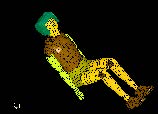Hybrid III dummy with helmet.
A soldier’s ability to survive a mine blast greatly improves if armored vehicles are equipped with energy-absorbing seats, according to recent studies by Ala Tabiei, Ph.D., an aerospace engineer at the University of Cincinnati.
The blast from anti-tank mines or improvised explosive devices, commonly called IEDs, can transfer shock waves from the floor of personnel carriers or other non-tank vehicles to the seats to the occupants, often with such force that it can crush the occupants and severely injure or kill them.
As part of his study, Dr. Tabiei developed and evaluated a new seat design for personnel carriers and other non-tank vehicles that mitigates an explosion’s force inside the vehicle. Instead of bolting the seat directly to the floor, he designed a seat attached to steel rails encased in aluminum tubes.
He first created mathematical formulas that represent different aspects of the vehicle. Next, he used special software, LS-DYNA 3D, to create a computer model of the vehicle, including seats, tires and human prototypes, and translate the formulas into a simulation.
By running this data-intensive model more than 500 times on the Ohio Supercomputer Center’s Intel Itanium2 computer cluster, Dr. Tabiei was able to perfect the simulation. Once he ensured the model accurately simulated the force and injuries caused by an explosive force, he could reliably test and modify the designs for energy-absorbing seats much faster and with far less expense than conducting full-scale, destructive tests.
Most importantly, computer simulations of the new design showed that the force of a mine blast now moves from the floor to the tubes, crushing them in the process — not the passengers.
“Many fatalities happen because of the acceleration pulses, not because of a direct hit from an exploding device. With an energy absorber between the floor and the seat of the occupant, we can start to mitigate the shock wave,” Dr. Tabiei said. “These findings are particularly exciting, because they could contribute to a whole new way of protecting soldiers’ lives.”
--
Project Lead: Ala Tabiei, Ph.D., University of Cincinnati
Research Title: Improvised Explosive Devices’ Effects on Soldiers in Iraq and Afghanistan
Funding Source: Army Research Laboratory through the Soldier’s Objective Force Electronics Reliability and Survivability Technology Program (SOldier FERST), and directed by the University of Nevada at Las Vegas
For more information: www.ase.uc.edu/~atabiei
